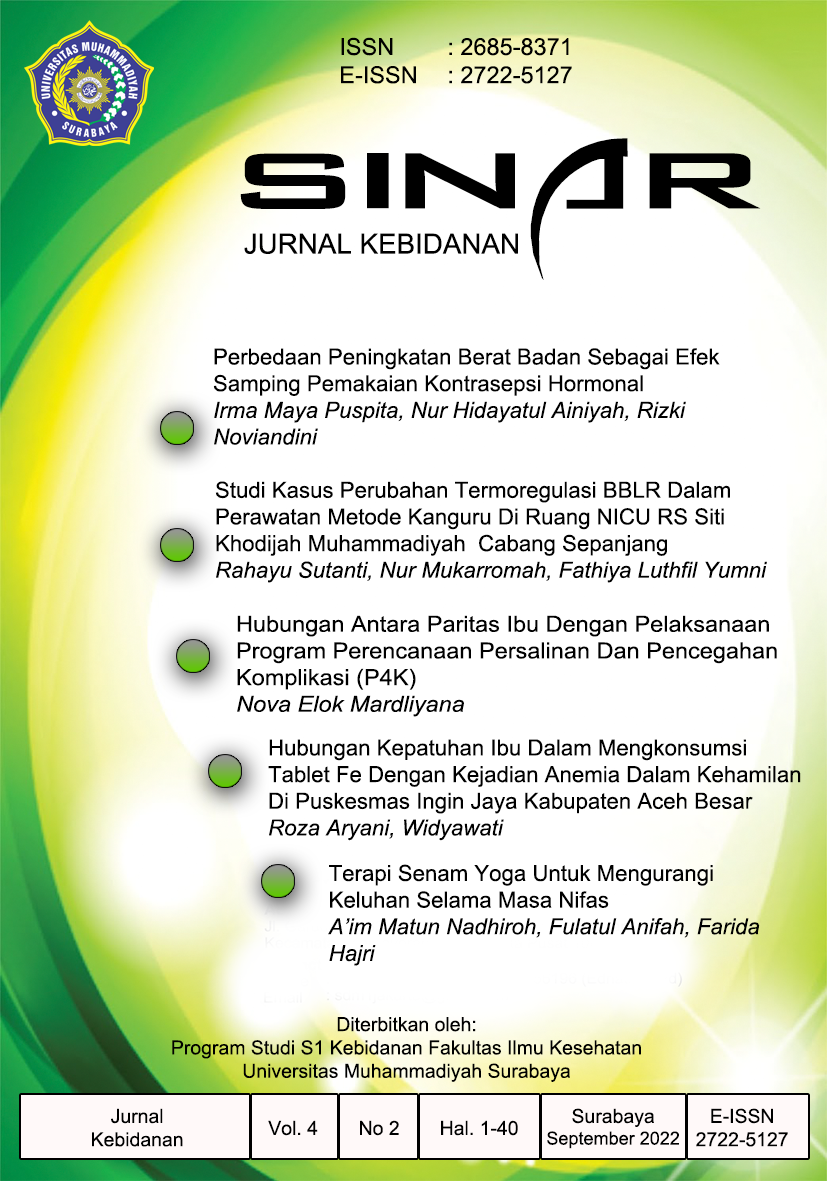Perbedaan Peningkatan Berat Badan Sebagai Efek Samping Pemakaian Kontrasepsi Hormonal
Abstrak
Objective: Hormonal contraception can affect weight gain, but the dose of hormones contained in combination pills and injections contraceptive is so small that there is almost no influence on body weight. The aim of this study was to determine the differences in weight gain as a side effect of hormonal contraception on combination pills and injections contraceptive acceptors.
Methods: The design of this study is a comparative study in which combination hormonal contraception is the independent variable and weight gain is the dependent variable. The sample in the study was taken by simple random sampling, while the population in this study were all acceptors of hormonal contraceptive pills and combination injection in Langkap village, Burneh sub-district with 151 acceptors. Data collection techniques used documentation, statistical test using chi-square and considered significant at 0,05.
Results: The results showed that p <α (0,02 <0,05). This means that HO is rejected and H1 is accepted, so there is a difference in weight gain as a side effect of hormonal contraceptives for combination pill and combination injection contraceptive acceptors.
Conclusion: With these results, the authors hope that people should choose contraception that is most suitable for themselves so that they can reduce complaints and side effects while using certain contraceptives.Artikel teks lengkap
Referensi
Budijanto, D. (2019). Profil Kesehatan Indonesia 2018. In Kementrian Kesehatan Republik Indonesia. https://doi.org/10.1080/09505438809526230
Darmawati1, & Fitri, Z. (2012). Kenaikan Berat Badan Pada Akseptor Kontrasepsi Hormonal Di Desa Batoh Tahun 2012. Ilmu Keperawatan, 1, 1–8. file:///C:/Users/Aroully/Downloads/4988-9928-1-SM.pdf
Firdy Liwang, Bhargah, A., Kusuma, H., Prathiwindya, G. G., Putra, I. G. I. S., & Ani, L. S. (2018). Gambaran Penggunaan Kontrasepsi Hormonal dan Non Hormonal di Wilayah Kerja UPT Puskesmas Tampak Siring 1. Intisari Sains Medis 2018 Volume 9 Nomor 3. Fakultas Kedokteran Universitas Sam Ratulangi. Manado, 9(3), 41–46. https://doi.org/10.1556/ism.v9i3.301
Kamariyah, N. (2014). Pemakaian Kontrasepsi Suntik Akan Mempengaruhi Berat Badan Akseptor KB Suntik di Kota Baru Driyorejo. Jurnal Ilmiah Kesehatan, 7(2), 150–156.
Liando, H., Kundre, R., & Bataha, Y. (2015). Faktor-Faktor yang Berhubungan dengan Peningkatan Berat Badan Ibu Pengguna Alat Kontrasepsi Suntik DMPA (Depo Medroksi Progesteron Asetat) di Puskesmas Kumelembuai Kabupaten Minahasa Selatan. 3, 3–9.
Mukaromah, A. (2016). Hubungan Lama Pemakaian KB Suntik DMPA dengan Perubahan Berat Badan di BPM Sri Lestari, A.Md.Keb Desa Pagersari Kecamatan Bergas Kabupaten Semarang.
Mulazimah. (2016). Perbedaan Pengaruh Penggunaan Kontrasepsi Pil Kombinasi Dan Kontrasepsi Iud Terhadap Perubahan Berat Badan Pada Akseptor Di Wilayah Puskesmas Sukorame. Akademi Kebidanan PGRI Kediri, 1–10.
Ningsih. (2017). Gambaran Jenis Alat Kontrasepsi dan Berat Badan pada Wanita Usia Subur di Kampung KB Sungai Dama Samarinda.
Perwira, I. (2014). Memahami Kesehatan Sebagai Hak Asasi Manusia. Pusat Dokumentasi ELSAM, 1–19.
Prijatni, I., & Rahayu, S. (2016). Kesehatan Reproduksi dan Keluarga Berencana.
Penulis
Hak Cipta (c) 2023 Irma Maya Puspita

Artikel ini berlisensiCreative Commons Attribution-NonCommercial-ShareAlike 4.0 International License.
Hak Cipta ada di penulis, jurnal ini berada di bawah Lisensi
https://creativecommons.org/licenses/by-nc/4.0/


